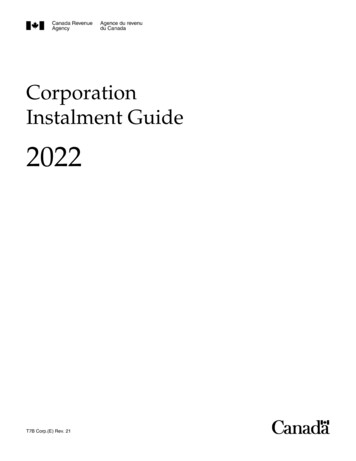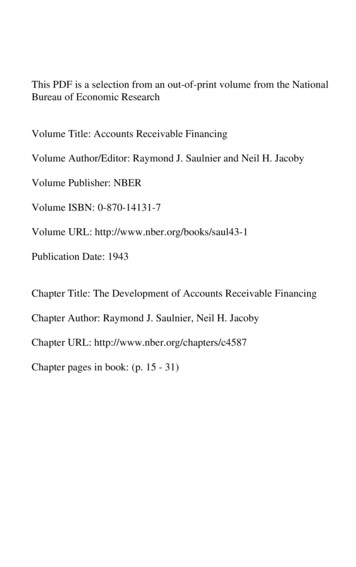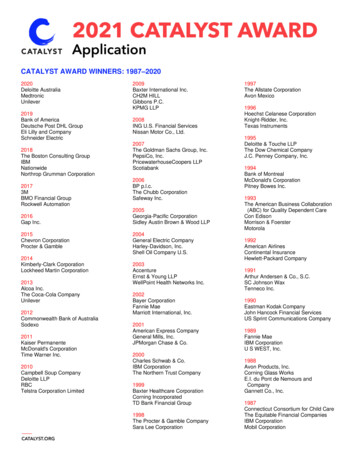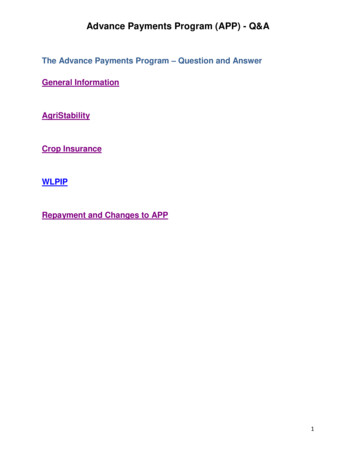
Transcription
CorporationInstalment Guide2022T7B Corp.(E) Rev. 21
Find out if this guide is for youThis guide will help you determine if your corporationneeds to make instalment payments and how to calculatethem.Generally, corporations have to pay their taxes ininstalments. An instalment payment is a partial payment ofthe total amount of tax payable for the year.The Income Tax Act requires most corporations to makeinstalment payments so that they are treated the same astaxpayers who have tax deducted from their income atsource. Some corporations, like new corporations and thosewith tax payable of 3,000 or less, may not have to paytaxes by instalment. Special rules may apply. Read “Findout if you need to make instalment payments” on page 4for more details.The Income Tax Act authorizes the Canada RevenueAgency (CRA) to charge instalment interest and penalty,and arrears interest, if we do not get the required paymentson time.NoteThe terms instalment payment and interim paymentare interchangeable. Either term may appear incorrespondence and publications you get from us. Theterm reporting period has the same meaning as the termtax year since both terms describe the period assessed.Our publications and personalized correspondence are availablein braille, large print, e-text, or MP3 for those who have a visualimpairment. For more information, go to canada.ca/cra-multiple-formats or call 1-800-959 5525. If you are outside Canada and theUnited States, call 613-940-8497. We only accept collect callsmade through telephone operators. After your call is accepted byan automated response, you may hear a beep and notice anormal connection delay.This guide uses plain language to explain the most common tax situations. It is provided for information only and does notreplace the law.La version française de ce guide est intitulée Guide des acomptes provisionnels pour les sociétés.Unless otherwise stated, all legislative references are to the Income Tax Act or, where appropriate, the Income TaxRegulations.canada.ca/taxes
Table of ContentsPageInstalment requirements .Find out if you need to make instalment payments .New corporations .Tax payable of 3,000 or less.Short tax years .44444Calculating your instalments.Parts I, VI, VI.1, and XIII.1 tax instalments .Calculate instalment payments online .Instalment payment worksheets .Step 1 – Calculating your estimated tax payableand tax credits for 2022 (Worksheet 1) .Step 2 – Choose: monthly (Worksheet 2) orquarterly (Worksheet 3) instalment payments .Step 3 Monthly option – Calculating your monthlyinstalment payments for 2022 (Worksheet 2) .Step 3 Quarterly option – Calculating yourquarterly instalment payments for 2022(Worksheet 3) .Special rules .Short tax years .Fluctuating filing period ending .Amalgamations .Wind-ups .Transfers or rollovers .Change of control .Specified future tax consequences .Part XII.1 – Tax on carved-out income .Reporting Part XII.1 tax .Calculating your instalments for Part XII.1 tax .Part XII.3 – Tax on investment income oflife insurers .Reporting Part XII.3 tax .Calculating your instalments for Part XII.3 tax .4444101010Due dates .Instalment due dates .Balance-due day .Amalgamations .Wind-ups .1010101111Statements .View and pay account balance.Online requests for statements and remittancevouchers .Statement of account .Register an alternate address .Manage addresses online .1111Paying your instalments .Making payments .Paying on time .Payment vouchers .Form RC159, Remittance Voucher – AmountOwing .Form RC160, Remittance Voucher – InterimPayments .Payments over 25 million.Owing 2 or less .4788999999991010101111111112121212PageTransfers .Transferring instalment payments .1313Refunds and overpayments .Refunding instalment payments .Direct deposit.Expecting a large refund .Transferring overpayments .1313131314Prepaying reassessments .14Interest and penalties .Instalment interest .Instalment penalty .Arrears interest .Refund interest .Carrybacks .Forgiven interest .Cancelling small amounts of penalty and interest .Cancelling or waiving penalties and interest .141415151516161616Appendices .Appendix 1 – Instalment base – Amalgamations[Regulation 5301(4)] .Appendix 2 – Instalment base – Wind-ups[Regulation 5301(6)] .Before the wind-up .After the wind-up .Appendix 3 – Instalment base – Transfers or rollovers[Regulation 5301(8)] .Before the rollover.After the rollover .Appendix 4 – Worksheet 2 – Example 1 .Appendix 5 – Worksheet 2 – Example 2 .Appendix 6 – Worksheet 3 – Example 3 .17Digital services .Handling business taxes online .CRA BizApp.Receiving your CRA mail online .Authorizing the withdrawal of a pre-determinedamount from your Canadian chequing account .Electronic payments .242424242424For more information .If you need help.Forms and publications .Electronic mailing lists .Teletypewriter (TTY) users .Due dates .Service complaints .Formal disputes (objections and appeals) .Reprisal complaints ada.ca/taxes3
Instalment requirementseligible small Canadian-controlled privatecorporation (CCPC), shorter than one quarter.Corporations generally make monthly or quarterlyinstalment payments toward their tax liability under thefollowing parts of the Income Tax Act:Calculating your instalments Part I – Tax on income Part VI – Tax on capital of financial institutionsParts I, VI, VI.1, and XIII.1 taxinstalments Part VI.1 – Tax on corporations paying dividends ontaxable preferred sharesThese taxes are added together to determine yourinstalment requirements: Part XII.1 – Tax on carved-out income Part XII.3 – Tax on investment income of life insurers Part XIII.1 – Additional tax on authorized foreign banksFind out if you need to makeinstalment payments Part I – Tax on income Part VI – Tax on capital of financial institutions Part VI.1 – Tax on corporations paying dividends ontaxable preferred shares Part XIII.1 – Additional tax on authorized foreign banksNew corporationsCalculate instalment payments onlineYou do not have to make instalment payments for a newcorporation until you have started your second year ofoperation. However, for your first year of operation, youhave to pay any tax you owe on or before your balance-dueday for that tax year. Part XII.1 tax, Tax on carved-outincome, is an exception to this. See page 10 for details.You can use the “Calculate instalment payments” service tocalculate instalment payments and view their due datesthrough:NoteYou may have to start making instalment payments foryour second year even before you pay your balance dueor file your first return. To help us allocate your firstpayment to the correct tax year-end, you can contact usto have your tax year-end established before you makethe first payment. Otherwise, the system will allocateyour first payment to a December 31 year-end.Your first tax year should start on your incorporation date.If you start your tax year after this date, it may affect yourrequirement to make instalments later.Tax payable of 3,000 or lessYou do not have to make instalment payments on yourfederal taxes if the total of your taxes payable underParts I, VI, VI.1, and XIII.1, determined before taking intoconsideration specified future tax consequences and beforethe deduction of current-year refundable tax credits foreither the current or previous year, is 3,000 or less[subsection 157(2.1)].If your Part XII.3 tax is 3,000 or less in the current orprevious year, you do not have to make instalmentpayments on this tax.Similarly, you do not have to make instalment payments onyour provincial or territorial taxes if the total of yourprovincial or territorial taxes for the current or previousyear is 3,000 or less.However, you have to pay your taxes, if any, on yourbalance-due day. Represent a Client at canada.ca/taxes-representatives, ifyou are an authorized representative or employee My Business Account at canada.ca/my-cra-business-account, if you are the business ownerInstalment payment worksheetsYou can use the following worksheets for the calculations:Worksheet 1 (T2WS1), Worksheet 2 (T2WS2), andWorksheet 3 (T2WS3). These can be found at canada.ca/cra-forms.We have split the instructions into 3 steps as follows:Step 1 – Start by estimating amounts for 2022Step 2 – Choose if you’ll be making monthly or quarterlypaymentsStep 3 – Calculate the amounts of each payment basedon 3 optionsStep 1 – Calculating your estimated taxpayable and tax credits for 2022(Worksheet 1)The first step when calculating your instalments is toestimate the total tax you have to pay under Parts I, VI,VI.1, and XIII.1 and the tax you have to pay to provincesand territories (other than Quebec and Alberta).Worksheet 1 is used to calculate these estimated amounts.NoteUnlike other provinces and territories, Quebec andAlberta administer and collect their own corporationtaxes. Corporations that earned taxable income in theseprovinces pay provincial tax directly to those provinces.Short tax yearsYou do not have to make an instalment payment for a taxyear that is shorter than one month, or in the case of an4canada.ca/taxes
Estimated tax payable for 2022Amount A – Estimated taxable income for 2022Enter the amount of taxable income you’re estimating foryour 2022 tax year.Estimated 2022 federal tax on income (amounts 1 to 3)Amount 1 – Base amount of federal tax on incomeMultiply your estimated income (amount A) by the currentfederal basic tax rate on corporations (38%).Amount 2 – Recapture of investment tax creditA corporation that disposed of a property used in scientificresearch and experimental development (SR&ED), orconverted it to commercial use, should report a recapture inits income tax return for the year in which the dispositionor conversion occurred. For more details on recapture ofinvestment tax credit (ITC), see “Line 602” in the T4012, T2Corporation – Income Tax Guide (T2 guide).Amount 3 – Refundable tax on Canadian-controlledprivate corporation‘s (CCPC‘s) investment incomeAn additional refundable tax of 10 2/3% is levied on theinvestment income (other than deductible dividends) of aCCPC. For more details, see “Line 604” in the T2 guide.Estimated 2022 non-refundable tax credits (amounts N1 toN11)Amounts N1 to N11 correspond to federal non-refundablecredits that you estimate will apply to your 2022 tax year.Amount N1 – Small business deductionCorporations that were CCPCs throughout the tax yearmay be able to claim the small business deduction (SBD).The SBD is 19% of whichever of the following amounts isless: the income from active business carried on in Canada,the taxable income, the business limit, or the reducedbusiness limit. For more details, see “Small businessdeduction” in the T2 guide.Amount N2 – Federal tax abatementThe federal tax abatement is equal to 10% of taxable incomeearned in the year in a Canadian province or territory.Income earned outside Canada is not eligible for the federaltax abatement.Amount N3 – Manufacturing and processing profitsdeductionCorporations that derive at least 10% of their gross revenuefor the year from manufacturing or processing goods inCanada for sale or lease can claim the manufacturing andprocessing profits deduction (MPPD). It allows them toreduce the Part I income tax that they must pay. The MPPDapplies to the part of taxable income that representsCanadian manufacturing and processing profits. Calculatethe MPPD at the rate of 13% on income that is not eligiblefor the small business deduction. For more details, see“Line 616” in the T2 guide.Amount N4 – Investment corporation deductionA Canadian public corporation that is an investmentcorporation, as defined in subsection 130(3), can claim adeduction from Part I tax that the corporation wouldotherwise have to pay. This deduction is equal to 20% ofthe taxable income for the year that is more than the taxedcapital gains for the year. For more details, see “Line 620”and “Line 624” in the T2 guide.Amount N5 – Federal foreign non-business income taxcreditA federal foreign non-business income tax credit isavailable to Canadian residents to prevent double taxationof any non-business income earned in a foreign countrythat was taxed by that foreign country. The credit is alsoavailable to authorized foreign banks on their Canadianbanking business from sources in a foreign country. Formore details, see “Line 632” in the T2 guide.Amount N6 – Federal foreign business income tax creditTo prevent double taxation, a corporation that pays foreigntax on income or profits it earned from operating a businessin a foreign country can claim a federal foreign businessincome tax credit. For more details, see “Line 636” in theT2 guide.Amount N7 or N8 – General tax reductionA general tax reduction of 13% is available on qualifyingincome. Corporations benefit from the general taxreduction only on taxable income that is subject to a rate of38%. This reduction generally does not apply to incomeeligible for the following deductions: Small business deduction (amount N1) Manufacturing and processing profits deduction(amount N3) Investment corporation deduction (amount N4)CCPCs enter the calculated amount at N7. Othercorporations enter the amount at N8. For more details, see“General tax reduction” in the T2 guide.Amount N9 – Federal logging tax creditCorporations that have income from logging operationsand have paid logging tax to the province of Quebec orBritish Columbia can claim this credit. For more details, see“Line 640” in the T2 guide.Amount N10 – Federal qualifying environmental trust taxcreditA corporation that is the beneficiary under a qualifyingenvironmental trust can claim a tax credit equal toPart XII.4 tax payable by the trust on that income. For moredetails, see “Line 648” in the T2 guide.Amount N11 – Investment tax creditA corporation earns an investment tax credit by applying aspecified percentage to the cost of acquiring certainproperty (investments) or on certain expenditures.For more details, see Schedule 31 or “Line 652” in theT2 guide.Estimated 2022 federal tax payable (amounts D to G)Amount D – Estimated 2022 tax payable on incomeAmount calculated on the worksheet.Amount E – Estimated 2022 tax payable on capital offinancial institutions (Part VI tax)Part VI levies a tax on a financial institution’s taxablecapital employed in Canada. Part VI tax is 1.25% of thetaxable capital employed in Canada that is more than the 1 billion capital deduction for the year. For more details,see “Line 720” in the T2 guide.canada.ca/taxes5
Amount F – Estimated 2022 tax payable on corporationspaying dividends on taxable preferred shares (Part VI.1tax)Generally, the first 500,000 of dividends paid in the yearon taxable preferred shares is exempt from Part VI.1 taxliability. This basic annual exemption is called thedividend allowance.However, the 500,000 dividend allowance is reduced ifyou paid more than 1 million of dividends on taxablepreferred shares in the previous year.For more details, see “Line 724” in the T2 guide.Amount G – Estimated 2022 additional tax payable onauthorized foreign banks (Part XIII.1 tax)Every authorized foreign bank is subject to Part XIII.1 taxequal to 25% of its taxable interest expense for the year. Formore details, see “Line 727” in the T2 guide.Amount I – Estimated 2022 net provincial and territorialtax payable before refundable creditsYou have to calculate and pay provincial or territorialincome tax in addition to your federal income tax.ExampleCorporation A resides and operates only in Nova Scotia. Itsestimated income for 2022 is 600,000 and is eligible for thesmall business deduction.Corporation A would estimate its provincial tax as follows:The lower rate of 2.5% applies to the first 500,000 (NovaScotia business limit). The amount over the 500,000business limit is taxed at the higher rate of 14%. The totalestimated net provincial tax is calculated as follows: 500,000 2.5% (lower rate) . 12,500 100, 000 14% (higher rate) . 14,000Total estimated net provincial tax . 26,500If you have a permanent establishment in more than oneprovince or territory, you have to calculate the taxableincome you earned in each province or territory and fileSchedule 5, Tax Calculation Supplementary – Corporations.See the schedule or Part IV of the Income Tax Regulationsfor more details. the income eligible for the federal small businessdeductionQuebec and Alberta do not have corporation tax collectionagreements with the federal government. If you have apermanent establishment in these provinces, send yourprovincial income tax return and your instalment paymentsfor the provincial corporation tax to the applicableprovince. the income based on limits established by the particularprovince or territoryFor more information, see the T2 guide or go to canada.ca/t2-return and select “Corporation tax rates.”Generally, provinces and territories have two rates ofincome tax—a lower rate and a higher rate.The lower rate applies to either:The higher rate applies to all other income. Variousdeductions, credits, and tax relief may affect the rates. Thisamount is net of provincial and territorial non-refundablecredits.Table of income tax rates and business limits for provinces and territoriesTax rate on taxable income eligiblefor the small business deduction(lower rate)Tax rate on othertaxable income(higher rate)Business limit3%15% 500,000Nova Scotia2.5%14% 500,000New Brunswick2.5%14% 500,0001%16% 500,0003.2%11.5% 500,000Manitobanil12% 500,000Saskatchewan0%12% 600,000British Columbia2%12% 500,000Nunavut3%12% 500,000Northwest Territories2%11.5% 500,000Yukon0%12% 500,000Province or territoryNewfoundland and LabradorPrince Edward IslandOntarioNoteThese rates are in effect January 1, 2022, and may change during the year.6canada.ca/taxes
Calculating your estimated refundable tax creditsfor 2022Your refundable federal, provincial, and territorial taxcredits are included in the calculation of your instalmentpayments. Use the estimated refundable credits (asappropriate) to calculate your total estimated refundabletax credits for 2022.Amounts R1 to R9Amount R1 – Investment tax credit refundAny investment tax credit you earned in the tax year mustfirst be used to reduce taxes payable to zero, before theremainder can be claimed as a refund. For more details, see“Line 780” in the T2 guide.Amounts R10 to R52Amounts R10 to R52 are the refundable tax credits availableto all provinces and territories (other than Quebec andAlberta).Information on these provincial and territorial refundablecredits can be found in Chapter 8 of the T2 guide under“Provincial and territorial tax.”After you’ve estimated your tax payable and refundablecredits, you can calculate your instalments.Step 2 – Choose: monthly (Worksheet 2) orquarterly (Worksheet 3) instalment paymentsAmount R2 – Dividend refundA private or subject corporation may be entitled to adividend refund for dividends it paid for the tax year. Formore details, see “Dividend refund” in the T2 guide.Monthly instalment paymentsAll corporations are eligible to make monthly instalmentpayments. Use Worksheet 2 (T2WS2) to calculate yourmonthly instalments.Amount R3 – Federal capital gains refundInvestment corporations and mutual fund corporationsmay be eligible for a federal capital gains refund. For moredetails, see “Line 788” in the T2 guide or Schedule 18.Quarterly instalment paymentsAmount R4 – Federal qualifying environmental trust taxcreditThe amount of federal qualifying environmental trust taxcredit refund that would not be used in the Part I taxcalculation. For more details, see “Line 792” in theT2 guide.Amount R5 – Canadian film or video production taxcreditA fully refundable tax credit is available to qualifiedcorporations that produce an eligible production certifiedby the minister of Canadian heritage to be a Canadian filmor video production. For more details, see “Line 796” in theT2 guide.Amount R6 – Film or video production services tax creditA fully refundable tax credit is available to eligibleproduction corporations for a film or video productioncertified by the minister of Canadian heritage to be anaccredited production. For more details, see “Line 797” inthe T2 guide.Amount R7 – Canadian journalism labour tax creditA refundable tax credit is available to qualifying journalismorganizations for qualifying labour expenditures payable toan eligible newsroom employee. For more details, see“Line 798” in the T2 guide.Amount R8 – Tax withheld at sourceThis is the amount shown as “income tax deducted” on anyinformation slips, such as NR4, T4A, or T4A-NR, you mayreceive. For more details, see “Line 800” and “Line 801” inthe T2 guide.Amount R9 – Provincial and territorial capital gainsrefundInvestment corporations and mutual fund corporationsmay be eligible for a provincial or territorial capital gainsrefund. For more details, see “Line 808” in the T2 guide orSchedule 18.A small Canadian-controlled private corporation (CCPC) iseligible to make quarterly instalment payments if, at thetime the payment is due: it has a perfect compliance history it has claimed a small business deduction for the currentor previous tax year together with any associated corporations, for the currentor previous tax year: it has taxable income of 500,000 or lessit has taxable capital employed in Canada for the taxyear of 10 million or lessWe consider you to have a perfect compliance history if,during the previous 12 months ending at the time your lastinstalment was due: you remitted on time all the amounts required forGST/HST, withholding under subsection 153(1), CanadaPension Plan contributions and employment insurancepremiums you filed on time all returns required under theIncome Tax Act or under Part IX of the Excise Tax Act(GST/HST)NoteWhen a corporation ceases at any time in a tax year to beeligible to pay quarterly instalments, the corporation isstill allowed to pay its next instalment due at the end ofthe current quarter; however, the corporation will haveto begin to pay monthly instalments following thatquarter.ExampleIf the corporation has made quarterly instalments onMarch 31 and June 30 and is currently deciding whether ornot a quarterly instalment on September 30 is allowed, seeif the corporation met the compliance requirementsthroughout the 12-month period ending June 30, which isthe due date of the last previous instalment.Use Worksheet 3 (T2WS3) to calculate your quarterlyinstalments.canada.ca/taxes7
Calculating your instalments for Parts I, VI, VI.1, andXIII.1 taxRegardless of whether you’re making monthly or quarterlyinstalment payments, you will have three options tocalculate the least amount of tax you have to pay byinstalment for the current tax year [subsections 157(1)and 157(3)]:Option 1 – current year estimated tax payableOption 2 – previous year tax payableOption 3 – a combination of the previous year and the yearbefore the previous year’s tax payableComplete worksheet 2 or 3 to determine the payableamounts under each option, then you can choose the optionthat results in the least amount payable by instalments.NoteFor Quebec and Alberta, do not enter the provincial taxpayable since it is paid directly to the province.Keep in mind that these are estimates and any remainingunpaid tax is payable on or before the balance-due day.We will assess your return using the option that results inthe least amount payable by instalments. We will chargeinterest if you use option 1 and your estimated tax waslower than the year’s actual tax and the tax calculated usingoption 2 or 3.NoteWe do not issue instalment payment reminder notices.Corporations are responsible for calculating andremitting their own instalment payments.Step 3 Monthly option – Calculating yourmonthly instalment payments for 2022(Worksheet 2)You can calculate the least amount of tax you have to payby monthly instalment payments using one of the followingoptions:Option 1 – One-twelfth (1/12) of the estimated tax payablefor the current tax year (2022) is due each month of the taxyearOption 2 – One-twelfth (1/12) of the tax payable from theprevious tax year (2021) is due each month of the currenttax yearOption 3 – One-twelfth (1/12) of the tax payable from theyear before the previous tax year (2020) is due in each of thefirst two months of the current tax year; then one-tenth(1/10) of the difference between the tax for the previous taxyear (2021) and the total of the first 2 payments is due ineach of the remaining 10 months of the current tax yearinstalment payments for Parts I and VI.1 using one of thefollowing options:Option 1 – One-quarter (1/4) of the estimated tax payablefor the current tax year (2022) is due each quarter of the taxyearOption 2 – One-quarter (1/4) of the tax payable from theprevious tax year (2021) is due each quarter of the currenttax yearOption 3 – One-quarter (1/4) of the tax payable from theyear before the previous tax year (2020) is due the firstquarter of the current tax year. One-third (1/3) of thedifference between the tax for the previous tax year (2021)and the first payment is due in each of the remaining threequarters of the current tax yearTo help you calculate your quarterly instalment payments,use Worksheet 3, Calculating your quarterly instalmentpayments for 2022.What to do if a corporation is
My Business Account at canada.ca/my-cra-business -account, if you are the business owner Instalment payment worksheets You can use the following worksheets for the calculations: Worksheet 1 (T2WS1), Worksheet 2 (T2WS2), and Worksheet 3 (T2WS3). These can be found at canada.ca /cra-forms. We have split the instructions into 3 steps as follows:










